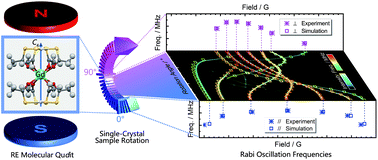Spin active molecules have been proposed for quantum computing, due to their unique advantages such as the possibility of having multiple eigenstates. Using pulse electron paramagnetic resonance, a Gd(III) complex was thoroughly investigated to demonstrate the protocol of harnessing the large spin quantum number of the rare-earth molecule and implementing a qudit. The desired anisotropy of the S = 7/2 system, which makes all spin transitions addressable with an X-band spectrometer, was quantitatively determined at 10 K with a set of crystal field parameters. The relatively long phase memory time, ca. 1 μs, of the oxygen-coordinated 4f spin was extended up to 16.8 μs using dynamic decoupling pulse sequences. An arbitrary superposition state between each adjacent level pair was achieved by Rabi cycles with a crystal sample positioned in both perpendicular and parallel directions. Finally, a more detailed orientation mapping of the Rabi frequencies, which govern the quantum phase gate operation time, was provided based on the spin Hamiltonian.
